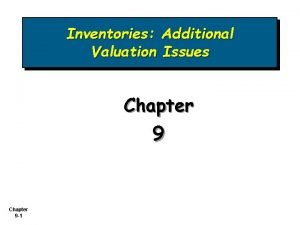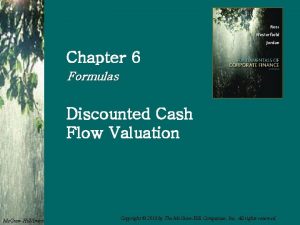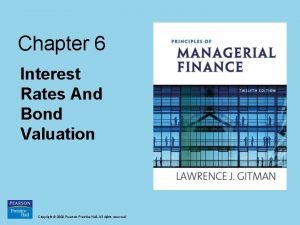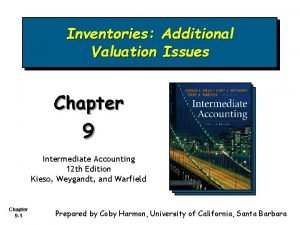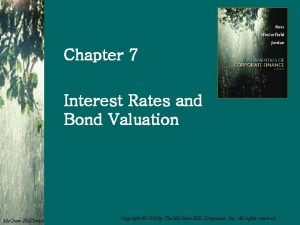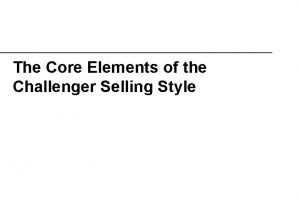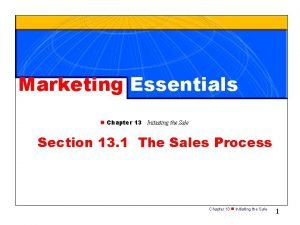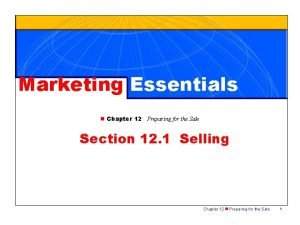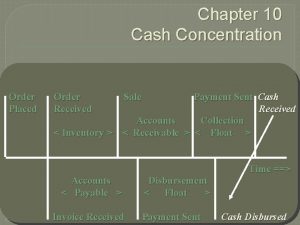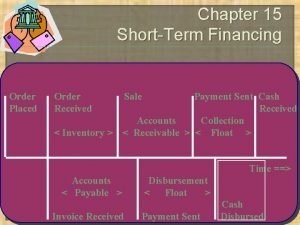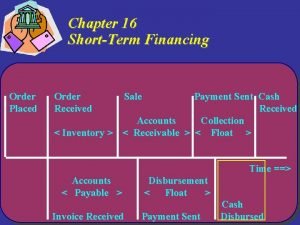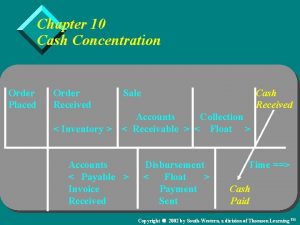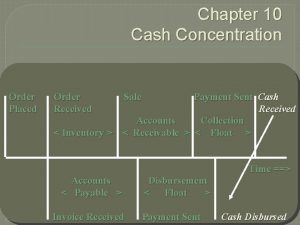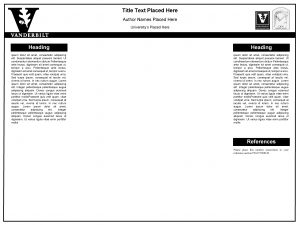Chapter 3 Valuation Order Placed Order Received Sale













- Slides: 13

Chapter 3 Valuation Order Placed Order Received Sale Payment Sent Cash Received Accounts Collection < Inventory > < Receivable > < Float > Time ==> Accounts < Payable > Invoice Received Disbursement < Float > Payment Sent Cash Disbursed Copyright 2005 by Thomson Learning, Inc.

Objectives v Use cash flow timeline and discounting techniques to value future cash flows. v Explain importance for using time value of money in short-term decisions. v Apply the NPV technique to select value-enhancing proposals. v Explain how short-term decisions fit with EVA. v Apply NPV to value changes in the cash conversion period. v Recognize difficulties in selecting appropriate discount rate. Copyright 2005 by Thomson Learning, Inc.

Two Financial Decision-Making Approaches v Financial statement approach v Valuation approach Copyright 2005 by Thomson Learning, Inc.

Financial Statement Approach v Approach – compute incremental revenue and expense effects of proposal – calculate anticipated profit effect v Calculation steps – estimate unit sales and multiply by profit margin – estimate capital costs of additional required investments such as receivables, inventory, etc. – estimate additional bad-debt loss if new credit terms – calculate overall profit effect v Decision criteria – if anticipated profit is >=0, proposal would contribute profit – if anticipated profit is <0, proposal would not contribute profit Copyright 2005 by Thomson Learning, Inc.

Valuation Approach v Approach – accounts for timing of cash flows – accounts for present values – results in making value enhancing decisions v Four steps – determine relevant cash flows – determine timing of cash flows – determine appropriate discount rate – discount cash flows v Decision criteria – if NPV >= 0 invest – if NPV < 0 do not invest Copyright 2005 by Thomson Learning, Inc.

Economic Value Added v Incorporates elements from both financial statement approach and valuation approach v EVA = Operating profit - (Cost of capital)(Capital employed) v Advantage: provides better company-wide understanding of importance of improved working capital management v Caution: can be misused if user does not take a long-term view Copyright 2005 by Thomson Learning, Inc.

NPV Calculations v Simple interest – 1 PV = FV x ---------k (1 + (------) x n) 365 v Compound interest – 1 PV = FV x -------k (1+ -------)n 365 Copyright 2005 by Thomson Learning, Inc.

Basic Valuation Model note: i = k/365. . . . CFo NPV = CFo CF 1 CF 2 CF 3 CFn + ------------- +. . + ------(1 + i x 1) (1 + i x 2) (1 + i x 3) (1 + i x n) Copyright 2005 by Thomson Learning, Inc.

Valuation Using NPV v Solving Digi. View’s financial dilemma Copyright 2005 by Thomson Learning, Inc.

Valuing Changes in the Cash Conversion Period v - Purchase Sale NPVCCP = -------- + --------(1 + i ) DPO (1 + i) DIH + DSO v NPV CCP-Aggregate = NPVCCP x Daily Sales / i v - Purchase Sale NPVCCP = [ ------- - -------- ] ln(1 + i) (1+i)OC-CCPP (1+i)CCPO+DPO Copyright 2005 by Thomson Learning, Inc.

Corporate Cash Holdings and Value v Late 80’s to mid 90’s: keep cash holdings low – long-term cost of funds > return on cash – cash holdings viewed as negative debt v Late 90’s to current: bond rating agencies penalizing for too little liquidity v Current trend: reduce working capital requirements but increased cash holdings v Pinkowitz and Williams (2002): investors mark up stock value $1. 26 per $1 of cash holdings Copyright 2005 by Thomson Learning, Inc.

Choosing the Discount Rate v Three unique problems – funds are rarely raised specifically to fund short-term type projects – short-time horizon implies short-term not long-term rate – risk should be accounted for, but may be ambiguous. v One-shot projects – if net borrower, use short-term borrowing rate – if net investor, use short-term investment rate v Multi-year projects – maybe appropriate to use cost of capital v Formulation – kadj = krf + kavg + k Copyright 2005 by Thomson Learning, Inc.

Summary v Short-term financial decisions can impact firm value by: – – – altering operating cash flows changing the length of the cash conversion cycle changing company risk posture impacting net interest income and by changing accuracy and timeliness of critical information. v Both financial statement approach and valuation offer insight in working-capital management decisions. v Choosing appropriate discount rate is an issue when trying to assess valuation impact. Copyright 2005 by Thomson Learning, Inc.
 Fixed income securities
Fixed income securities 1st order 2nd order 3rd order neurons
1st order 2nd order 3rd order neurons Chapter 7 interest rates and bond valuation
Chapter 7 interest rates and bond valuation Chapter 9 inventories additional valuation issues
Chapter 9 inventories additional valuation issues Chapter 6 discounted cash flow valuation
Chapter 6 discounted cash flow valuation How to find the price of a bond
How to find the price of a bond Chapter 6 interest rates and bond valuation
Chapter 6 interest rates and bond valuation Chapter 9 inventories additional valuation issues
Chapter 9 inventories additional valuation issues Chapter 7 interest rates and bond valuation
Chapter 7 interest rates and bond valuation Chapter 6 interest rates and bond valuation
Chapter 6 interest rates and bond valuation Challenger selling style
Challenger selling style Chapter 13 initiating the sale
Chapter 13 initiating the sale Marketing essentials meaning
Marketing essentials meaning Discount received in accounting
Discount received in accounting



